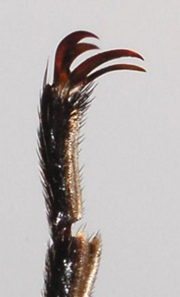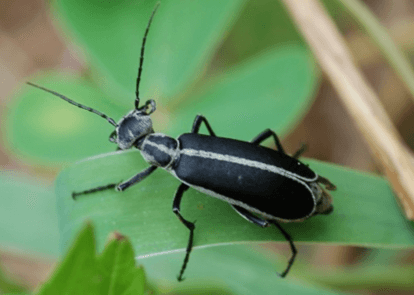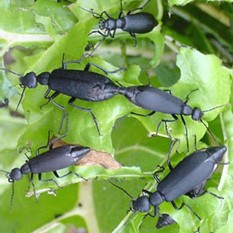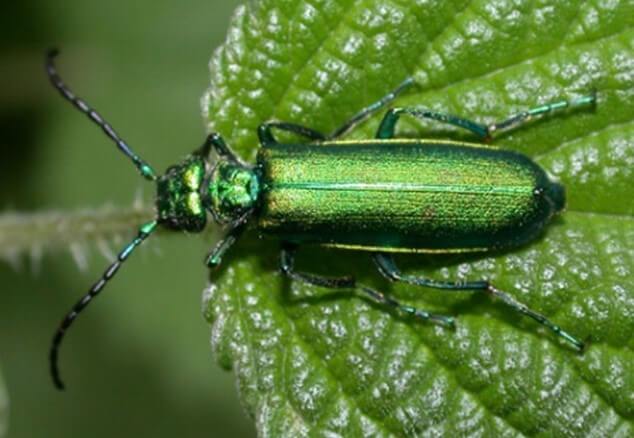Agriculture and Natural Resources Blog
Contact
Jon Zawislak
Assistant Professor, Apiculture and Urban Entomology
Phone: 501-671-2222
Fax: 501-671-2252
Email: jzawislak@uada.edu
Office:
University of Arkansas
Division of Agriculture
Cooperative Extension Service
2301 S. University Avenue
Little Rock, AR 72204
Austin Jones
Instructor and Director of Undergraduate Education,
Entomology and Plant Pathology
Phone: 479-575-2445
Email: akj003@uark.edu
Office:
University of Arkansas
Dale Bumpers College of
Agricultural, Food, and Life Sciences
Entomology and Plant Pathology
PTSC 217
University of Arkansas
Fayetteville, AR 72701

Blog Series: What's that bug?
Blister Beetle
By Jon Zawislak, Assistant Professor – Apiculture and Urban Entomology and Austin Jones, Instructor and Director of Undergraduate Education – Entomology and Plant Pathology
Blister beetle is the common name for members of the beetle family Meloidae. This family contains about 2,500 species in 120 genera worldwide. At least 14 species are native to Arkansas and found in a variety of color patterns and body shapes. They are fairly large insects, ranging between ¾” and 2” long. Blister beetles have a distinctly narrow “neck” – the pronotum – which is thinner than the head. Also, it is thinner than the rest of the thorax and abdomen and tapers toward the front. Their elytra, the protective hardened forewings that beetles are known for, are relatively soft and leathery, and they may wrap around the sides of the body of some species and can be very short in others. Blister beetles can be easily confused with members of the family Oedemeridae, known as the false blister beetles, but these have a pronotum that tapers towards the rear and lack “split claws” at the end of each leg.


Key characteristics – for identifying beetles in the family Meloidae include the “split claw” and a pronotum that is distinctly narrower than the head, which tapers towards the front. Photos by NCSU Agriculture and Life Sciences.
What are the feeding patterns of adult blister beetles?
Adult blister beetles feed on a wide array of plants, with some species feeding solely on flower parts while others prefer consuming foliage. Some species are particularly fond of solanaceous vegetables (potatoes, tomatoes, peppers, eggplants) along with beets and chard, and they are considered voracious, if only occasional, pests. Blister beetles often disperse and remain in low population densities for most of their lives but will suddenly aggregate into large mating and feeding swarms when mature and can cause considerable damage to vegetation. Farmers and gardeners may be surprised to see large numbers of adults that appear suddenly, causing significant plant loss in a very short time.

What are the behavior patterns of blister beetle larvae?
While adult beetles can do serious damage to plants, the larvae of some species feed on grasshopper eggs and are considered beneficial for controlling those pests. Larvae of the blackened blister beetle, Epicauta atrata, will also attack the eggs of the striped blister beetle, Epicauta vittata. Many blister beetle species are kleptoparasites (a term for stealing food or provisions from another species) that feed on pollen provisions and larvae of ground-dwelling solitary bees. Some Epicauta larvae will climb onto flowers or other vegetation, produce a scent that attracts a male bee, then hitch on for a ride. Once the male finds a female to mate with, the larvae will transfer to the female and ride back to the bee’s nest to prey on that bee’s offspring and provisions. Larvae of blister beetles may also become cannibalistic if no other food sources are available.
Blister Beetle – toxin production
Blister beetles earned their common name by producing a toxic terpenoid substance called cantharidin, which can cause blistering of the skin and mucous membranes, along with irritation to the digestive and urinary tract of mammals when ingested. Young beetles accumulate cantharidin as they feed and grow during their larval stages and will exude this defensive compound from their mouths or leg joints when threatened. Only male beetles continue to produce cantharidin as adults, which they can transfer to adult females during mating.

The infamous "Spanish Fly" – was actually a type of European blister beetle, Lytta vesicatoria.
Photo by Franco Christophe (CC BY-SA 3.0).
Cantharidin has a particular reputation as a human aphrodisiac, and when used as such is a substance often referred to as Spanish Fly. This concoction has most commonly been prepared from the secretions, or ground-up bodies, of a bright green iridescent European blister beetle, Lytta vesicatoria, which is sometimes called the Spanish fly. No, they are not from Spain, nor are they flies, so go figure! Cantharidin has also been incorporated into traditional North African culinary spices. However, the supposed benefits of cantharidin are actually the result of urinary tract irritation or inflammation, and when too much is ingested has led to accidental poisonings and even death. A fatal dose of cantharidin is said to range between 10-65 milligrams for humans, showing that the risks associated with its consumption far outweigh the benefits.

Are blister beetles harmful to animals?
Cantharidin remains potent, even in dead insects, their body parts, or secretions. Some blister beetles are highly attracted to alfalfa, and adults sometimes congregate in great numbers in hay fields and large numbers of beetles can end up crushed and baled into the hay. Blister beetle poisoning (cantharidiasis) results when livestock feed on contaminated hay. Symptoms can include tongue and mouth blistering, abdominal pain, colic, rapid pulse and respiration, diarrhea, blood or intestinal lining discharge in stools, and problems with urination or bloody urine. Cattle, sheep, alpacas, emus, and poultry are all sensitive to cantharidin toxicity, but horses are particularly susceptible, occasionally resulting in death.
If blister beetle poisoning is suspected, contact a veterinarian immediately. For more information on this hazard to livestock, or recommendations for control in pastures, consult the Arkansas Extension publication FSA-7054, Blister Beetle Management in Alfalfa. For infestations in commercial soybeans or edamame, consult MP-144.
Blister Beetles in Arkansas
In Arkansas, there are one to two generations of blister beetles per year. Early-emerging adults begin to appear in May–June. These can produce another generation in which adults emerge in August-September. The maximum emergence of adults occurs in July, when large congregations may be observed on plants; however, few of the later-emerging adults contribute to the second generation. Since the generations overlap, many adults may be present in the field from late May to late October. Females deposit eggs in the soil, with larvae quickly dispersing to seek food. The later generation will overwinter as larvae, and finish pupating the following spring.
See the photos below for blister beetles common to the Natural State.

Striped Blister Beetle
Epicauta vittata
Photo by McClarren & Reago
(CC0)

Orange Blister Beetle
Zonitis vittigera
Photo by Jim Elve
(CC BY-NC)

Margined Blister Beetle
Epicauta funebris
Photo by Mary Keim
(CC BY-NC-SA)

Black Blister Beetle
Epicauta pensylvanica
Photo by Steven Mlodinow
(CC BY-NC-SA)

Blackened Blister Beetle
Epicauta atrata
Photo by Theo Witsell
(CC BY-NC)

Squash Blister Beetle
Epicauta conferta
Photo by Laura Gaudette
(CC BY 4.0)

Short-winged Blister Beetle
Meloe angusticollis
Photo by Angela
(CC BY-NC-ND)

Forest Blister Beetle
Nemognatha nemorensis
Photo by Rick Nirschl
(CC BY-NC-SA)

Buttercup Oil Beetle
Meloe americanus
Photo by Karen Daughtery
(CC BY-NC-ND 4.0)